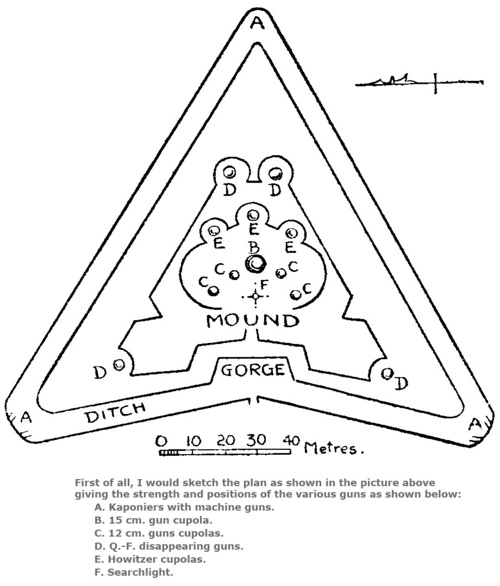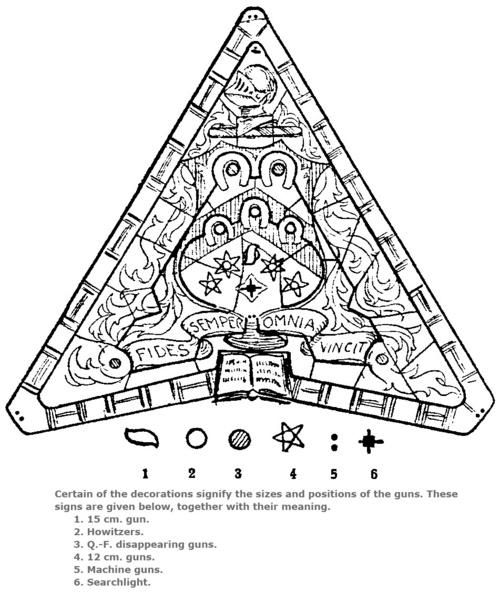June 12, 2012
Charles R. Knight, Designer of Stained Glass and Inventor of Dinosaurs
Last weekend I heard a radio piece called The Man Who Invented Dinosaurs, in conjunction with the recent publication of the book, Charles R. Knight: The Artist Who Saw Through Time, by Richard Milner.
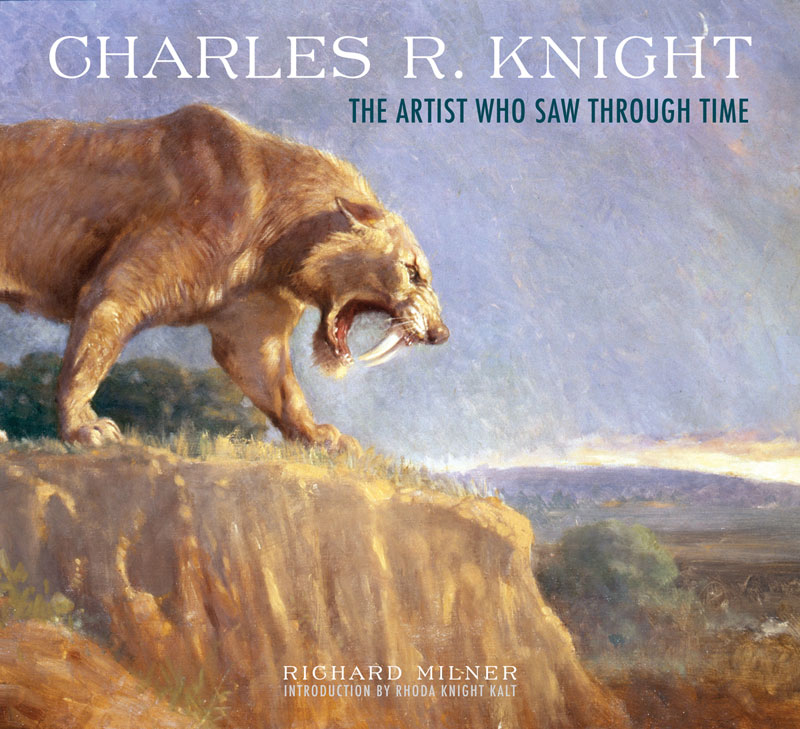
The artist is Charles R. Knight (wikipedia entry), and what was not mentioned on the radio show and what few people know, is that he worked for a short time as a stained glass designer, and most importantly, wrote a short account of that experience.
Granted, he only worked in stained glass for 2 years when he was a teenager. Nevertheless, the account he wrote of that experience is quite interesting and a worthwhile read for anyone interested in American stained glass history. His account is in Charles R. Knight: Autobiography of an Artist, with annotations by Jim Ottoviani. The chapter called Craftsman (pages 21-31) is of most interest, being an account of his 2 years working at Lamb Studio in New York, from about 1890-1892.
As far as I know, none of the design work he did for stained glass has been specifically identified and attributed to him, but seeing that he mostly did background and decorative elements, that is no big surprise. I'll update if I get more information.
January 28, 2012
Stained Glass Picture Puzzle
This sketch is from a book published in 1915, drawn around 1900-1902, by a person of some renown.
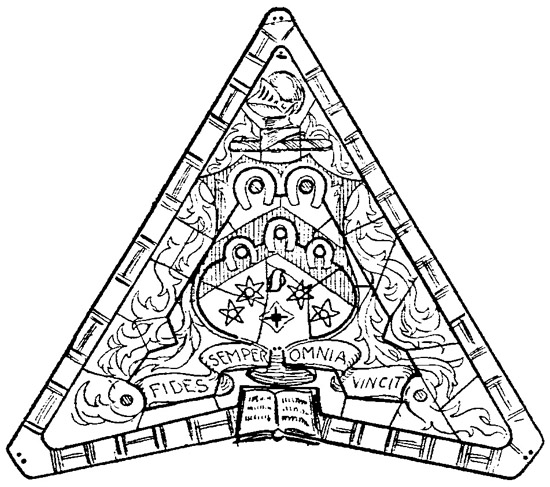
On first glance this would appear to be a sketch for a stained glass window.
It is not. So what is it?
Find out below the fold...
It's a Secret Map!
It's by Lieut.-Gen. Sir Robert Baden-Powell, K.C.B., one of the founders of the Boy Scouts and the author of the original Scouting for Boys. Baden Powell was also an artist/illustrator who did the illustrations for Scouting for Boys and is reputed to have drawn every day of his life. In his book, My Adventures as a Spy, Baden Powell recounts how, as a spy during the Boer War, he would pose as a butterfly collector or an artist and draw disguised depictions of military positions, fortifications, etc. The book is a surprisingly jaunty look at being a British spy during the Boer War in the 1890's. Like Baden Powell, it is a strange mix of funny and creepy.
This is from the section called "The Value of Being Stupid"
On the other hand, the exceedingly stupid Englishmen who wandered about foreign countries sketching cathedrals, or catching butterflies, or fishing for trout, were merely laughed at as harmless lunatics. These have even invited officials to look at their sketch-books, which, had they had any suspicion or any eyes in their heads, would have revealed plans and armaments of their own fortresses interpolated among the veins of the botanist's drawings of leaves or on the butterflies' wings of the entomologist. Some examples of secret sketches of fortresses which have been used with success are shown on the following pages.
Anyway, I do like puzzle pictures, and I like the idea of real stained glass windows with hidden maps and puzzle components (without them being instruments of war, of course). Lots of ideas popping into my head.
September 19, 2011
Habibi, a graphic novel
Not a post on stained glass, though I think it will be interesting to see if this will reach the SG world, in terms of its graphics. I've long thought that contemporary comics artists could end up having a serious influence on contemporary stained glass.
This book's official release is tomorrow and it's called Habibi, by Craig Thompson. I've been following the progress of this book for at least 3 years, through Thompson's blog - the Doot Doot Garden. His drawing skill is pretty stunning.
I can't speak for the story (yet), but the graphics look amazing.
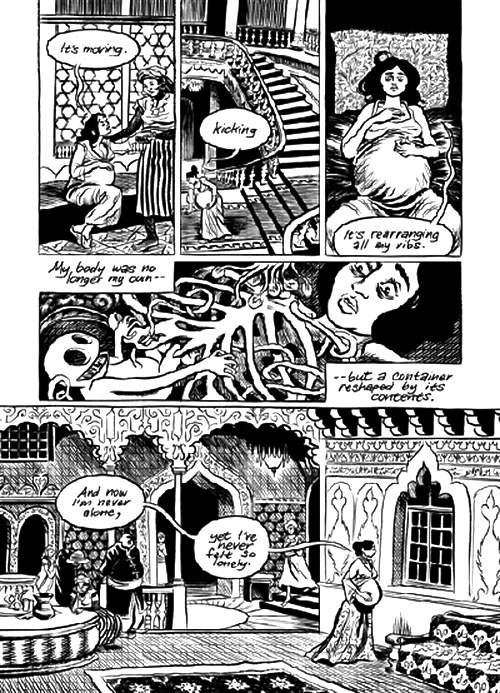
April 17, 2010
BIG Halftones in Architecture
Bjarke Ingels: 3 warp-speed architecture tales - a TED talk
Danish architect Bjarke Ingels rockets through photo/video-mingled stories of his eco-flashy designs. His buildings not only look like nature -- they act like nature: blocking the wind, collecting solar energy -- and creating stunning views.
The most interesting part for me is the third project, 'The Mountain Apartments", where he uses the halftone process, but applied in a uniquely architectural manner. If you want to see just that bit, it's from 12:43-13:15. The whole video is just over 18 minutes long.
These images are from Flickrite roryrory, who has posted quite an impressive collection of images of contemporary architecture.
Exterior of the building focusing on the photo of Mount Everest.

Closer Exterior of a corner of the building, where the halftone dots are just becoming visible.
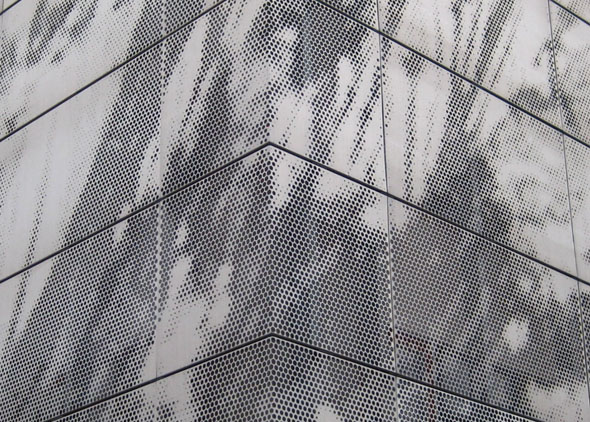
Interior showing the holes in the metalwork clearly
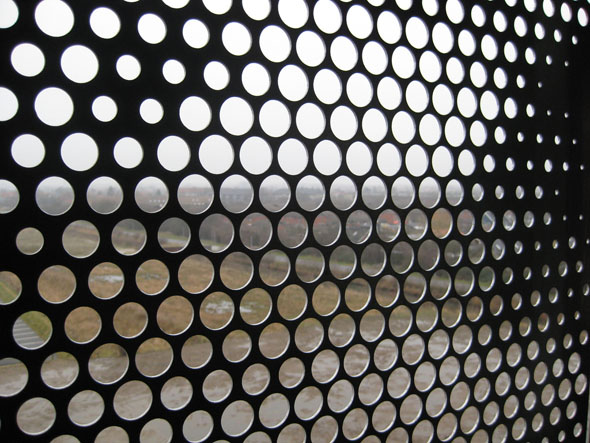
March 18, 2010
Nina Paley, Copyleftist
As a preview of my epic, long-in-the-making-but-not-posted-yet blogpost on copyright issues, I give a fun preview of the concept of the "copyleftist" - a 'minute meme' from questioncopyright.org.
All Creative Work is Derivative -
Read about the process and ideas behind All Creative Work is Derivative (scroll down past the video).
Nina Paley is a cartoonist and animator who made a feature length animated film called Sita Sings the Blues, which ran into copyright infringement issues. Her reaction was not to pay hundreds of thousands of dollars to free it up for traditional distribution, but to let it be open and free to the public at large.
So, carve out the time and go see Sita Sings the Blues (81 minutes). It's free for the viewing, or downloading, and it's good, too.
I can't pretend that I understand yet how she makes money with the Sita Distributtion Model, but I find the whole idea intriguing and I certainly have an open mind on the subject.
February 05, 2010
Arthur Ganson: Machines and the Breath of Time
Talking about tinkering, here is another video with the Kinetic artist Arthur Ganson. I had posted his brief TED talk in 2008. This is a more recent talk and a much longer one, for the LongNow Foundation. Wait for a leisurely 88 minutes where you have time to watch and drink it in. I love his work and have always wondered how some of the kinetic aspects of his work might be applied to glass art.
[Oops, just discovered that the embedded version is only 10 minutes long (weird.), so here is the link to the full 88 minute version of Arthur Ganson: Machines and the Breath of Time.]
November 18, 2009
La Gazza Ladra
Been crazy busy recently so little posting. So I'll build on a previous post I wrote in April about the 'stained glass-like' artist Emmanuelle Luzzati.
I've found his most 'stained glassy' looking film. La Gazza Ladra, 1965. It's also the first Luzzati/Giannini film I ever saw, and it's still my favorite. The name translates as "The Theiving Magpie", and the music is an overture by Gioachino Rossini.
And yes, one of the reasons I do like this is that it is his most stained glassy and there are any number of frames that could easily be translated to stained glass.
October 27, 2009
Hey, Get a load of that Strained Glass Window!
I gathered these clips awhile ago, but never managed to post them. I guess that it seemed like I was making too fussy a point to bother posting it. Well, I've been busy and thought I may as well throw these on the blog out of mere curiousity.
It's long bothered me how movies get stained glass windows wrong. Specifically, how they get the idea of how a stained glass window will break wrong. They cannot conceptualize that a stained glass window is a matrix of metal with glass inserts. They show it as if it is a sheet of glass. So the impact of crashing into a stained glass window is done with a big sharp sounding crash and lots of shards of glass breaking apart. The truth is that unless the impact is very great the impact would be with a thud and there would not be shards of glass flying everywhere.
first example -
"Robin Hood, Prince of Thieves", the Kevin Costner version.
The business with the stained glass window is at 3:15. Do yourself a favor and just go straight to that and watch only that. This is an incredibly bad movie no matter how you look at it, and it only gets worse with age.
Even a human body will not shatter a stained glass window like this, especially considering that any stained glass window the size of a human body will have support bars. Kevin Costner would as likely have bounced off the window entirely. Which, considering the quality of the movie, might have been an improvement.
"State and Main" - The actual scene that botches up the effect of breaking the stained glass window is such a small part of the movie that I wouldn't even mention it, except that it is actually mentioned in the dialogue as something of a plot point that the stained glass window in the firehouse is the only thing of value in the town. Again, it breaks as if it is one big sheet of glass, though mercifully there are no exploding shards of glass. At least 'State and Main' is a reasonably watchable movie. Though I would also say it's mostly of interest to hardcore David Mamet fans. David Mamet and comedy just don't seem a comfortable mix, imho.
The set-up for the 'value' of the stained glass window - at 1:38
The window breaking is shown in the trailer at 1:54 -
Pinocchio (1939) - Okay, it's a cartoon, and Disney at that, but I can remember picking up on this even when I was a teenage hobbyist in the 70's. The scene is at 2:20, when Lampwick picks up a brick and hurls it at the 'strained glass window', which shatters like a single sheet of glass. A big tinkling exploding bang. Hey at least this is a genuinely great movie with only a minor annoyance for a nitpicky stained glass artist like me... (not embedded)
October 19, 2009
Sendak-Mania 3 - "I Was There" audio part 2
I was able, over the weekend, to find and digitize the second part of the old audio recording of the mostly Q&A session with Maurice Sendak, from 1983 -
Maurice Sendak at Harvard, 1983 (hour 2).
Again, the file size is big, about 27mb. The sound quality is not great, though not too bad considering this is coming from a 26 year old cassette tape. I actually had to perform surgery on the tape to be able to transfer it. The tape itself was fine, but the tape-case had warped over time, so it wouldn't play. I had to remove the tape and put it into a different case. Very delicate operation, that is.
As I said about part 1, I hadn't remembered him being so funny. The last time I listened to this part of the talk was at least 5 or 6 years ago, and I've heard a number of more recent talks and interviews since then. It's nice to hear him in his prime, when he laughed more at life, but was able to balance it with the intelligence, depth and passion he's known for. I consider the bit about the 'all powerful female mystery' to be pure Sendak - slightly shocking, but insightful and hilarious as well, all the while leaving you with an indelible image.
Like the first part, I broke it down into selected highlights.
you can see below the fold...
all times are approximate -
0:00 - 6:00
Continuing on about The Juniper Tree.
Would you ever illustrate an adult book?
Would you design for Broadway shows as opposed to Opera?
Experience of working in Opera.
6:00 - 12:50
Do kids write you letters?
The Toronto 'Outside Over There' letters
A note from Danny
What is the background for In the Night Kitchen?
12:50 - 24:00
What is the origin of Higglety Pigglety Pop?
What about Pierre?
Where did Pierre come from?
15:00 - 17:20
What responses are there to your books in other countries?
What do think about the translations?
17:20 - 19:30
How do you feel about being famous?
You said you were timid in the past - where were you timid in some of your other books?
19:30 - 24:15
How do you approach set design?
How do you adapt illustration ot set design?
What is your work process for set design?
24:15 - 31:45
Is the story true of an autistic child speaking their first words after exposure to Wild Things?
What was your technique for Zlateh the Goat?
How have you been influenced by comics?
Relates his early job working in comic strips.
Are you still interested in comic strips?
Relates his thoughts on Little Nemo.
and how comic book artists are pigeonholed like children's book artists.
31:45 - 34:00
What kind of things do you think you can do on the stage that you cannot do in children's books?
How much do you think of the audience when you work?
34:00 - 38:30
Do you have contact with other children's book authors and illustrators?
Talks about William Steig, Tomi Ungerer and Dr. Seuss.
Relates his theories on the psychology of Dr. Seuss.
38:30 - 41:30
So do you really just make the work for yourself?
Were you influenced by EC comics?
What about your animated films?
Tells of The animated Really Rosie.
Will you do it again?
41:30 - 49:45
Re: Outside Over There, is there a sexual undertone to it?
What are the things you said you wish you could express, but can't?
Talks about the 'all powerful female mystery'.
How does Outside Over There relate to the set designs for The Magic Flute?
Do you think people will see those things you put into your work?
49:45 - 52:30
Do you feel a need for being socially responsible?
What about social committments?
Did you consciously choose children as models?
52:30 - 54:46
You seem so at ease answering questions - do you do this often?
Do you do a circuit? Or much public speaking?
No, and on that note, I'll stop speaking.
October 06, 2009
Sendak-Mania
Steven Heller interviews Maurice Sendak for Time Out magazine. Just a part of the mad deluge of Sendak related events and articles surrounding the upcoming release of the movie version of Where the Wild Things Are. There is Wild Things Week in New York, including an exhibit at the Morgan Library Where the Wild Things Are: Original Drawings by Maurice Sendak.
I've written about Sendak a number of times on this blog. From my first confession about The Sendak Thing from March 2004, to Yes, I need Tuesday, with a link to an interview in Horn Book Magazine. There is also Sendak's Descent into Limbo – Oct 2005 with a link to a video of him at MIT talking about We are All in The Dumps With Jack and Guy, perhaps my favorite 'Late Sendak' work. Also, Sendak in NYC, centered on an exhibition at the Jewish Museum in New York, and Sendak on NPR, from June 2005. Amazingly, all the links I tried are still live.
I must admit I am very skeptical about the movie, from the trailer and the featurette and the movies I've seen by Spike Jonze. I didn't much like 'Being John Malcovich' (great idea that falls apart in the second half), and liked 'Adaptation' even less.
Still, the marketing campaign for 'Wild Things' has been pretty interesting, especially the blogs like Terrible Yellow Eyes, a blog of 'Wild Things' inspired artwork, and Spike Jonze's own blog about the movie of Wild Things called We Love You So.
[update October 13, 2009 - via Michael Sporn's animation 'splog' - The best Sendak Mania website for images of Sendak sketches is at the Animazing Gallery website, which has a page of art from an exhibit called Sendak in Soho. Very nice stuff.]
August 01, 2009
Kalman Can Do
There has been a continuing series of wonderful web-based graphic essays by Maira Kalman created for the New York Times, most recently on American subjects like Thomas Jefferson (Time Wastes Too Fast), The Supreme Court (May It Please The Court), Abraham Lincoln (In Love With A. Lincoln), and the American Town Hall Meeting (So Moved). Kalman works in a unique style mixing handwritten text with photos or found images and her uniquely simple, highly personal paintings. Eclectic but coherent, I find these a great mix of graphics/text, all present to serve the content.
This past week came her best essay yet, in my opinion - Can Do, initially about Benjamin Franklin, but eventually becoming more a general essay on invention in America with, hidden inside, that simple but powerful message - Go Invent Something. Good advice in these challenging times.
Interesting that she includes patent pages within the essay. Last April, I started looking at stained glass patents in Google Patents, culminating with my blogpost on steel wheel glass cutters. I'm working on a few more "Google Patent" posts, including ones on Belcher Mosaic patents (and all the wacky variants through the years) and the dueling patents of Tiffany v. LaFarge.
This is one example of a very significant stained glass related patent (albeit with a rather boring looking patent image) -
Joining Glass Mosaics, by Sanford Bray, Boston, 1886
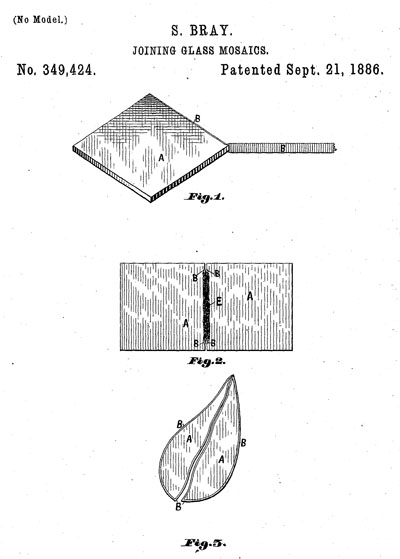
This is the original patent for the copper foil method of construction.
Without this invention, there would be no Tiffany Lamps, and no Judith Schaechter panels, and no... well, about 60% of my own work.
So -
Thank You for your inventiveness, Sanford Bray, whoever you are.
March 12, 2009
Stained Glass at the City Museum
The most unique cultural institution in St. Louis is without doubt the City Museum. It is not so much a museum as it is a playground that happens to be a work of art, as well as a place for a collection of lots of stuff. It has, among other things, its own aquarium, its own circus troupe, a second hand clothing store, a glass blowing studio, a "museum of mystery, mirth and mayhem', tons of caves to climb through and a jungle gym set like no other, called 'MonstroCity'.
Photo of MonstroCity from flickrite 'mesjak'

Kids and artists love it. Parents do too, even with the slight air of danger. A friend of mine called it a 'parental anxiety machine'. I've never seen the same expression of wild unfettered creativity expressed in any public venue before. It is to St. Louis' credit that they simply let this thing happen.
There is also stained glass, in one form or another, peppered throughout. I've posted a City Museum stained glass flickrset on my flickr account - City Museum, St. Louis - Stained Glass Plus. I'll continue to add more as I take more pictures in the future.
In the meantime, I have a brief overview of what's at the City Museum, mostly in terms of the stained glass, below the fold...
[update Sept. 26, 2011 - Sad to hear of the death of Bob Cassilly, the founder and creative driving force behind the City Museum. Deepest condolences to his family, friends and co-workers. Let's hope the City Museum can continue to thrive for many years as a testiment to his vision.]
Mosaics
The first thing you see are the mosaics.
This video is a much better intro to the mosaics than anything I can come up with, and it also gives a good general intro to the atmosphere of the City Museum.
From "Living St. Louis", a local PBS TV series -
about the creator of the mosaics - "Sharon Von Senden - Mosaics" (7:19)
Architecture Hall
These images are located in the Architectural Artifacts section of the City Museum. This is one of my favorite sections of the museum though not so popular, probably because this is the one area that is more museum and less playground.
They have some 10-12 stained glass windows within this area, though most of the Hall is filled with decorative stonework.
Landscape Window
This landscape window is probably my favorite of the stained glass pieces.
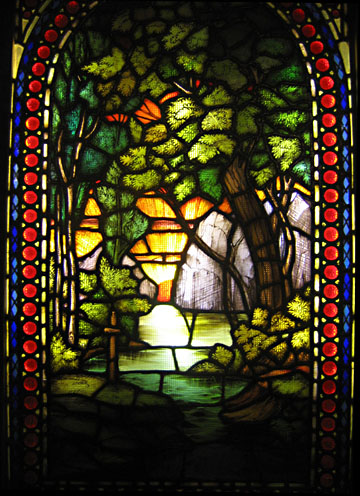
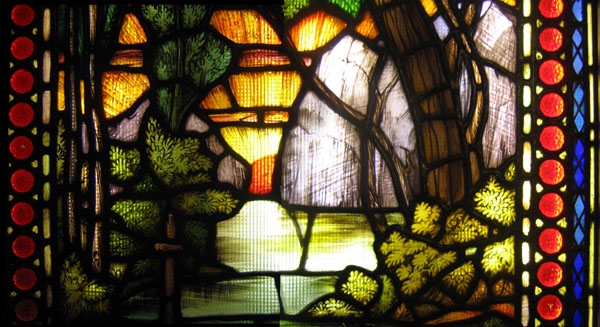
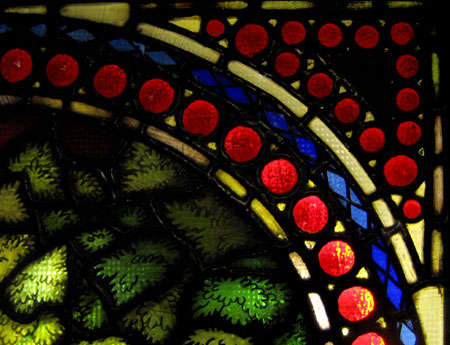
I suspect that this might be a mausoleum window, especially after I came across this image of this stained glass in Flushing Cemetary.
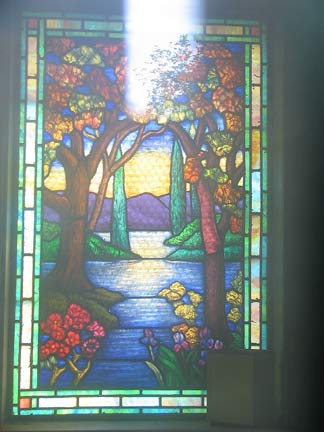
These next two images are from the Flickr set by Dimberly
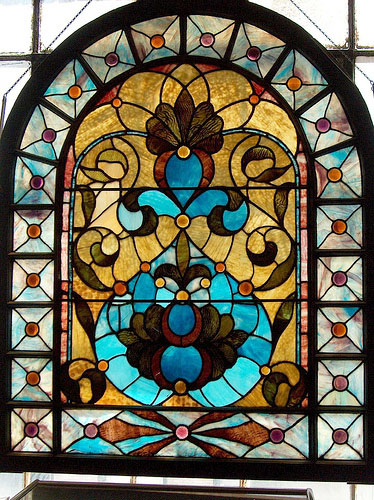
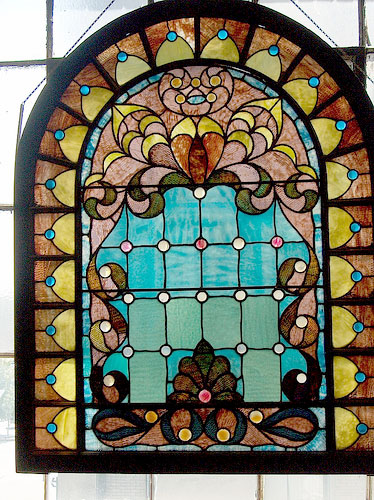
Aquarium Patchwork Window
There are about 4 or 5 stained glass windows in the aquarium. This patchwork window is the largest. I believe some of the glass in this was made at the on site glass blowing studio. Note that it is in a real aquarium. This window is right by the 'sting ray viewing platform'. There is an alligator only about 30 feet away.
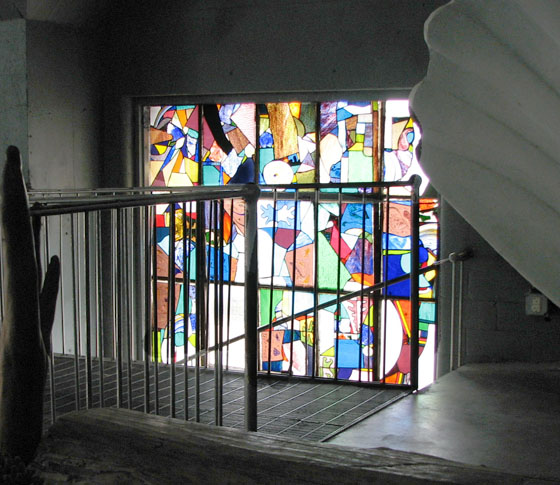
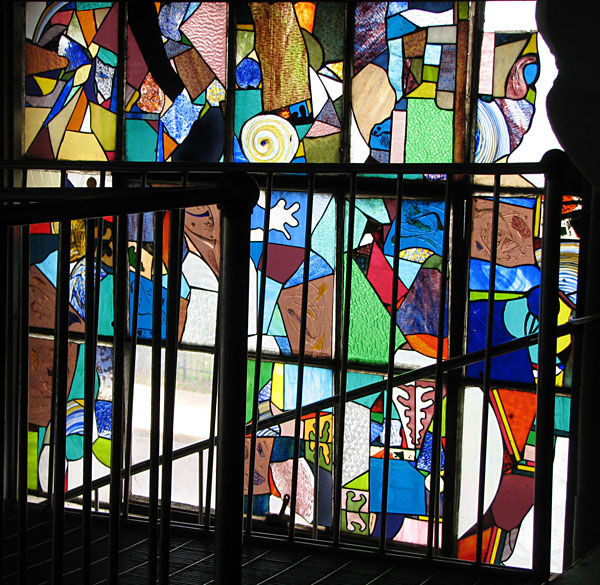
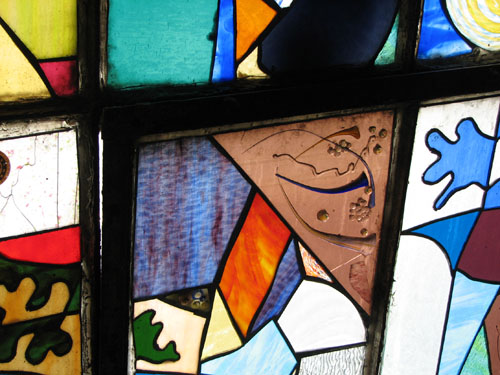
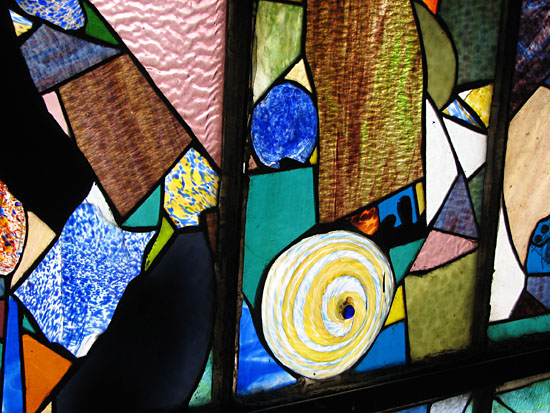
Bowl Wall
This is a wall sectioning an area where they have birthday parties and the like. It is in the same room as a vast playground, kind of an indoor skate park without skaters. I think it was considered too dangerous to let actual skaters loose on this. Kids go wild in here. Seriously.
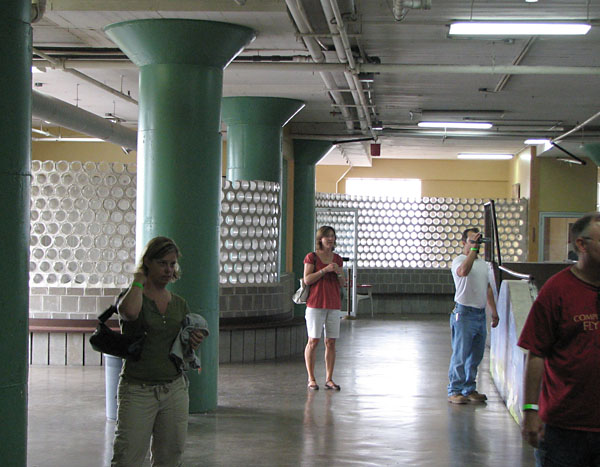
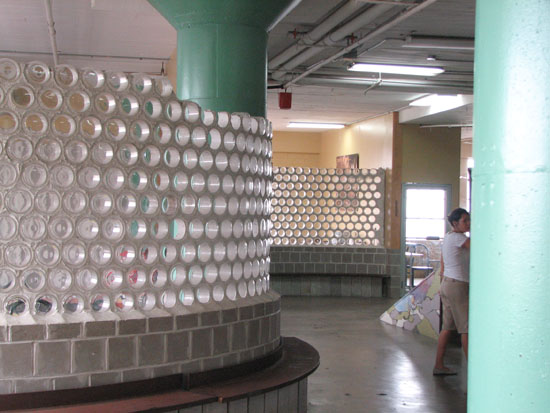
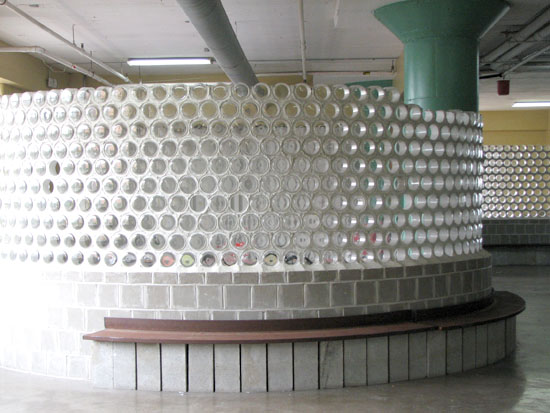
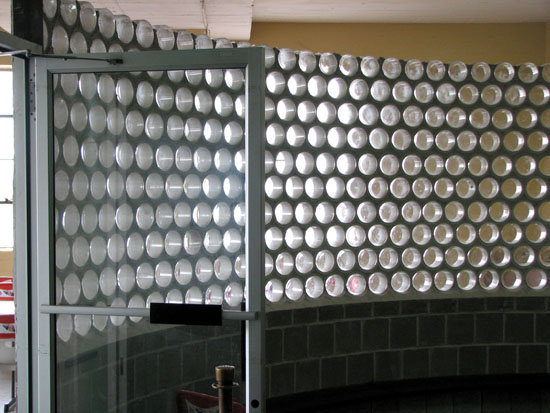
Clear Bottle Wall
This is one of two clear bottle walls in the museum, near one of the exits leading to MonstroCity. Thee bottle are glued together with clear silcone caulk.
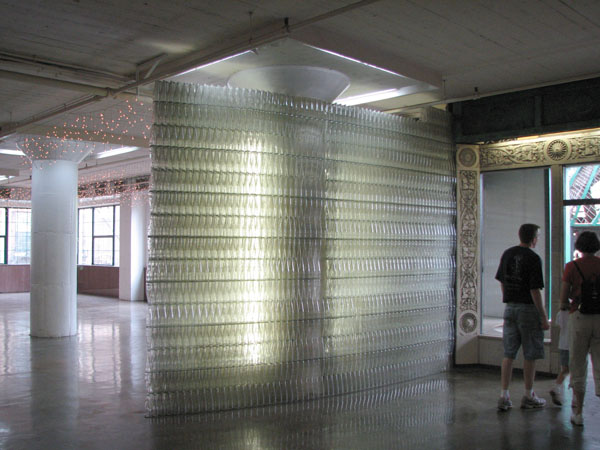
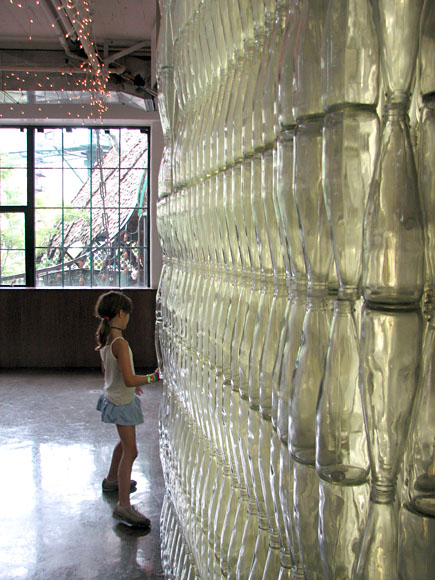
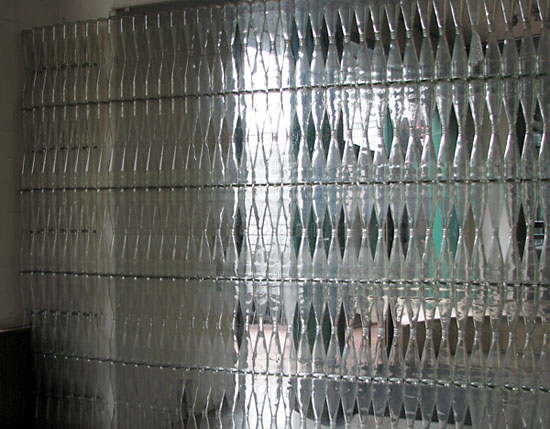
from rsun78 flickr page
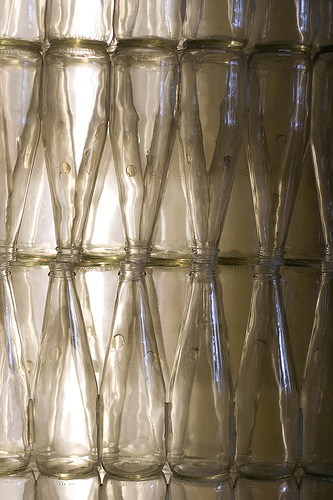
Big Clear Bottle Wall
This bottle wall is similar the the 'small bottle' bottle wall, only with large bottles. I've never seen large, clear, thin-neck bottles like this and I'm not sure what they would have been used for. It's located on the fourth floor, where there is a small knick knack shop and a large warehouse sized room with a shop selling vintage clothing.
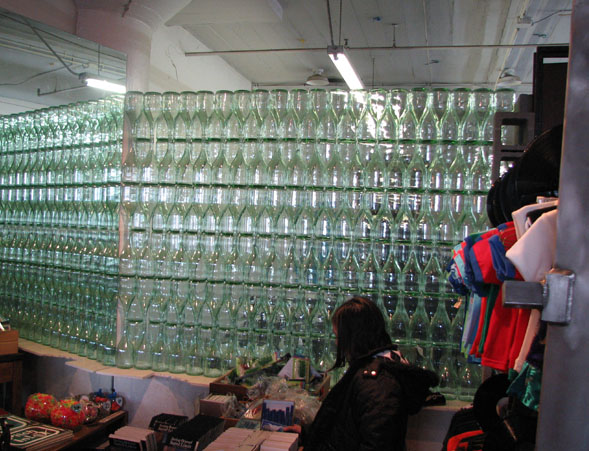
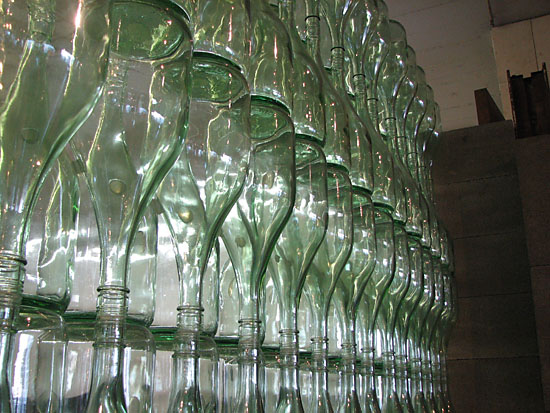
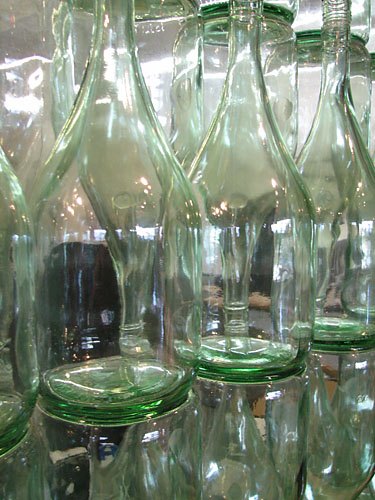
Oh, did I mention the room filled with old opera posters. That's a favorite of mine too, but it will have to wait for another time...
For more images, I suggest a Flickr search for City Museum, St. Louis. There are thousands and thousands of City Museum images.
There are also some interesting interactive panoramic images of the City Museum, through a thing called Gigapan. Not unlike Zoomify, but with extreme wide angle images.
January 16, 2009
StainedGlass™ Collage
Curious - though it really is just photocollage with lines added, or not.
Note the trademark symbol after 'StainedGlass', as in StainedGlass™ - again, curious.
And even more curiouser when you see the whole thing is actually some kind of research project.
Okay, I guess it's no more curious than the fact that Harvard University holds a registered trademark on the word Orgy®.
[Currently groovin' to the 'Jazz Funk' Orgy® online]
December 30, 2008
How Buildings Learn
What with the holidays and my work schedule, it's been crazy busy lately, so no consistent posting. While I've been working, I've been watching/listening to various lectures and documentary series, mostly on google video, and mostly on favored topics like art and architecture. To me they are kind of like audio books, only with pictures. Nice for when I'm doing the really boring benchwork.
One of the series recently seen is How Buildings Learn, by Stewart Brand. Brand has posted the entire six-part, three-hour BBC TV series, which first aired in 1997, and is based on Brand's book of the same name.
The series as a whole is kind of slow going, but I like Brand's viewpoint. Simply put, that buildings are constantly changing things, and it's a good thing. The trick is how to go with the flow.
Stewart Brand is an unlikely architectural critic, seeing that he's best known as the creator of the Whole Earth Catalog, and is more recently best known for addressing issues regarding new media.
There is no specific mention of stained glass in the whole 6 parts, but there is one mention of glass in architecture in the first episode, where he refers to the poorly thought out use of glass in modern architecture.
Embedded here is that first episode, called 'Flow'.
If you want to only see the part about glass it's from 6:15 to 9:15.
December 24, 2008
Hallelujah
Okay, nothing to do with stained glass (and just skip the first 1:30), but 'tis the season, and I dare you not to smile.
Joyeux Noël
November 12, 2008
Sketchface?
This is the 'Artist Bio Photo' I created this past summer for the AGG Conference 2008 website.
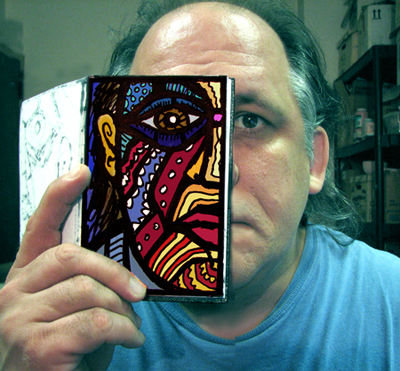
Funny thing is that when I made this I hadn't yet heard about Sleeveface, a similar idea to what I did with my sketchbook, only using vinyl album covers.
An example of 'Sleeveface' -
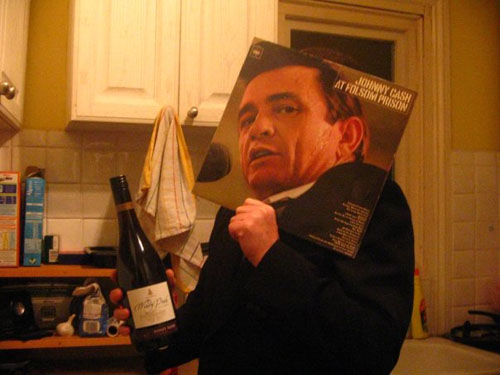
credit: Drew Goorney
Sleeveface was begun by a couple of Brits at the beginning of 2008, and it took off in a way that only viral internet things can. It's to the point where there are now thousands of sleeveface-type images on the web, and Sleeveface now has a book and and an ever growing Flickr prescence.
Truth be told, my 'sketchface' variant might be considered a bit of a cheat, in that I colored it in the computer. Still, could something like 'Sleeveface' evolve into 'Sketchface'? Who knows...
November 06, 2008
The Secret Life of the Electric Light
A video, made in the early 90's, from a series called The Secret Life of Machines.
Nothing about stained glass, but since stained glass is so often lit by artificial light these days it is relevant and this program does provide an interesting and informative background to how electric light works. The part about neon and flourescent light in the second half (starting around 13:15) would seem especially useful.
There were 18 such programs produced, covering items like washing machines, vacuum cleaners, refrigerators, photocopiers, fax machines. All episodes are available to view for free online at exploratorium.edu (quicktime required).
September 12, 2008
Arthur Ganson
Kinetic Sculpture by Arthur Ganson - Not at all about stained glass, but I remember this artist when he was just starting out in the Boston area some 25-30 years ago and doing his handmade gears from ordinary wire. He's come a long way and is making remarkable work. I only wish someone would bring this kind of inventiveness and thoughtfulness and humor, not to mention engineering skill, to architectural glass work.
A 15 minute demonstration recently posted by the TED people, from 2004 -
July 30, 2008
The Nature of Glass Disputed
Kenneth Chang of the New York Times has an interesting article about disagreements in the scientific community about the Nature of Glass. I can't say I'm able to follow much of it, but it is still a fun read with terms like 'ideal glass' and 'dynamical heterogeneity'.
And do also check out the rather curious tale of Buzz Aldrin's Flashlight.
July 27, 2008
What It Is
Speaking of drawing - another item promoting the preservation of the practice of hand drawing - Lynda Barry's new book, What It Is.
It is part autobiography and part creative manual, but the heart and literal center of the book - the part I like best - is the short graphic essay called "The Two Questions", which deals in general with why children abandon drawing as they grow older.
I agree with the conclusion - to all the kids who quit drawing... come back!
July 26, 2008
Secret of Drawing revisited
I mentioned in a previous post about a series on the BBC called The Secret of Drawing. I've now come across full length videos for 3 of the 4 episodes, on Google Video, plus one on YouTube. I'm embedding one part of part one, and linking to the Google videos -
Each episode is approx. 55 minutes long -
Episode 1 - The Line of Enquiry - website info, video is now available on YouTube in 6 parts - part 1.
Introduction to the series - The program presents drawing as utilitarian and observational drawings, going from scientific, anatomical, and nature drawing to Turner's abstracted observations of nature and Constable's landscapes.
Epeisode 1 - The Line of Enquiry, part 1 of 6 - embedded
Episode 2 - Storylines - website info, Google video.
It's nice to see otherwise lowbrow arts like Comic Books, Graphic novels, Japanese Manga, Storyboard Art, and Film Animation be covered as drawing, and therefore as legitimate 'Art'. Still, the show's perspective is a bit too much reliant on the 'artist as lone genius' perspective on creating art. For instance, in the segment on Comics, the emphasis is solely on the lone comics creator, in this case on Daniel Clowes. There is no mention of comics made in the more common commercial manner - made by multiple artists with one person writing, a different person doing the composition in pencil, another drawing in the lettering, another inking over the pencil lines. Several different hands drawing to create a whole work of art. Similarly, and more amazingly, there is little mention of the number of hands required to make an animated film. There is only the emphasis on the lone animator again.
Episode 3 - All in the Mind - website info, Google video.
Basically set around the idea of 'Why do people draw?" Going from cave paintings to outsider artists. The compulsion to depict the world, real or imagined, in drawn form. Is it for the artist or the audience, or both?
Episode 4 - Drawing By Design - website info, Google video.
Focusing on drawing as purely to be realized in other media. Architectural drawings, drawings for rock concert and theater set designs. The most interesting part of this is where he distinguishes between practical architectural design and architectural fantasy drawing.
In general, the series is as interesting for what it does not feature as much as for what it does. Still, it is rare to see any kind of emphasis put on drawing, and I like it. No mention of drawing for stained glass, of course, but many of the ideas are relevant, especially in this last episode. I like the idea of applying architectural fantasy drawing to stained glass. That is, I'd like to see a variety of artists create stained glass fantasy commissions in drawn form.
May 13, 2008
Artist and Patron
More video comic relief - this time from The Secret Policeman's Biggest Ball.
Again, not related directly to stained glass, though it does explore the unique and mysterious relationship that exists between an artist and a patron. As art commission situations go, this is actually not too far off the mark - at least it can feel like this sometimes.
May 09, 2008
Rufus Butler Seder
Did you know? The number one best selling children's picture book this week, according to Publisher's Weekly, is by a glass artist. The book is called Gallop!: A Scanimation Picture Book. The artist is Rufus Butler Seder, and I should note that he doesn't call himself a glass artist. He's more like an inventor/artist/filmmaker who happens to work with glass. The picture book is an extension of his Kineticards.
The glass art comes in with the glass tile murals that he calls Lifetiles. These are lenticular glass tiles that show a remarkable range of motion. The story of how he developed the process is fascinating.
There is no way that you can get the proper effect of any of this with a still image, so you have to see the videos. There are none to embed, but he's got a page of videos of the murals and videos of the gallery works for sale on his website.
Keep in mind as you look at the videos that all you are seeing is glass and fired-in paint. Nothing else. So, the materials are just the same as a piece of painted glass in a stained glass window.
Rufus is well known in the Boston area and I had the pleasure to be in an exhibit with him in 1996, at the time that the Glass Art Society held a conference there.
Portion of a flyer for the 1996 exhibit -
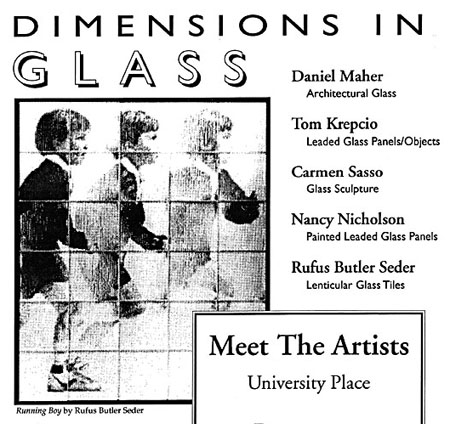
Congratulations Rufus for being a best seller!
May 08, 2008
Stained Glass Pie Chart
Very curious. At least it's not a pie chart for religious consumer spending.
April 22, 2008
What is Art?
A curious comic interlude.
Nothing about stained glass.
Still, stained glass is art, and what is art?
April 21, 2008
Stained Glass Brains
An interview with Dr. Jill Bolte Taylor, where she explains why she creates Stained Glass Brains. File under 'stained glass as self-reflexive art therapy'.
[update May 2, 2008 - Dr. Jill Bolte Taylor was named #41 in TIME magazine's 100 most influential people. No mention of the stained glass.]
February 01, 2008
I Only Wish it Were Glass
This is a piece of backlit gallery art, utilizing transmitted light just like stained glass, but this is not stained glass - it's brown packing tape on plexiglass, by artist Mark Khaisman.
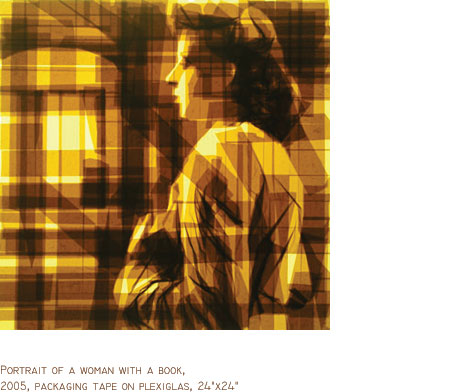
I like the images and I'm kind of fascinated by the process, and I'm always drawn toward light-based art, and I can see where he would like the spontaneity of working in this process. Still, it's packing tape and plexiglass. I can't help but think of the archival implications of using these materials - that is, isn't this likely to simply fall apart in a few years as the adhesive degenerates?
Glass is used for a reason - it lasts.
